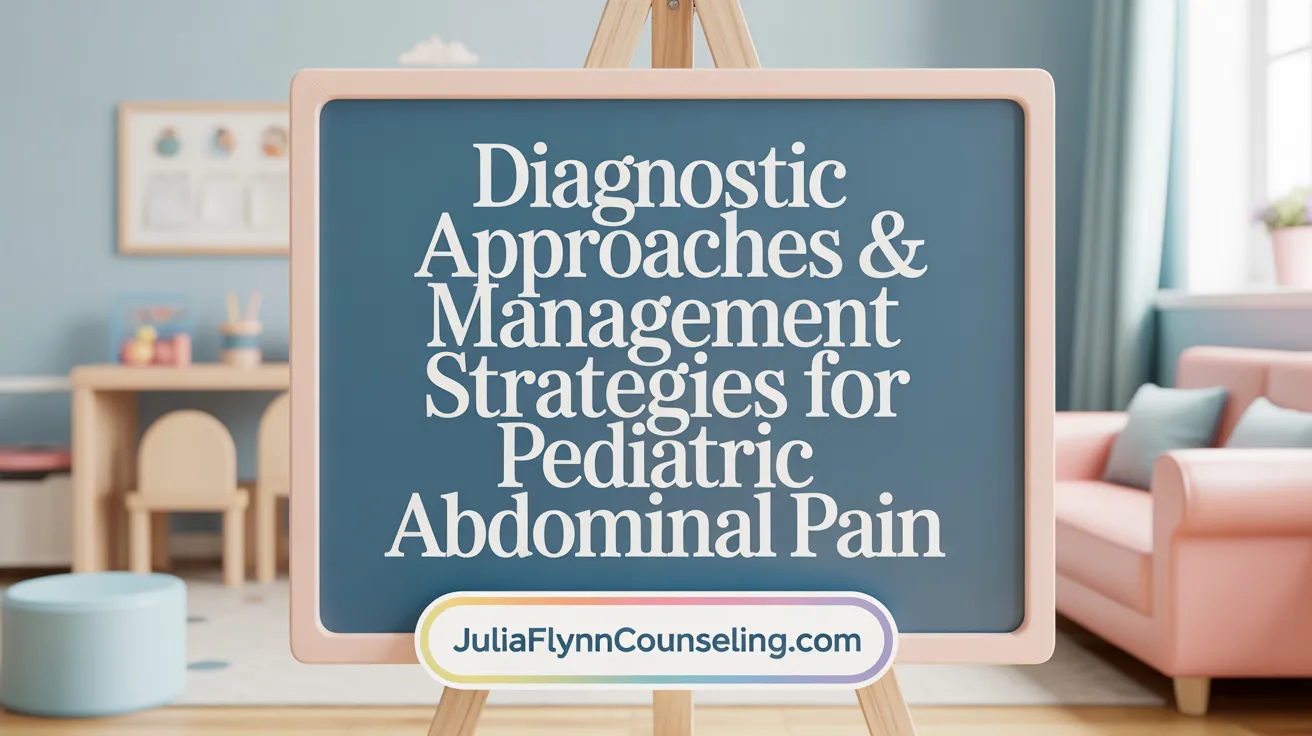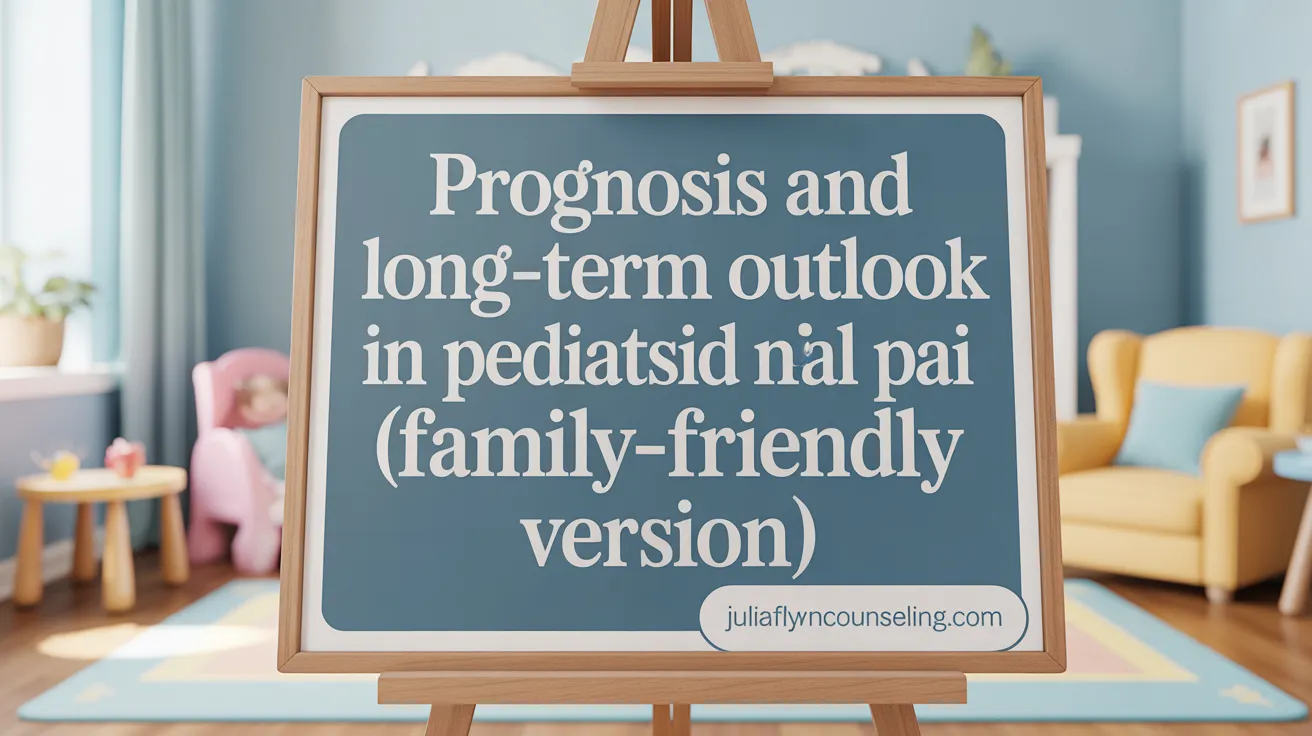Introduction to Abdominal Pain in Children
Abdominal pain in children is a frequent reason for medical visits and a significant concern in pediatric healthcare. With a broad spectrum of potential causes ranging from benign functional disorders to urgent surgical emergencies, understanding the common etiologies and patterns of emergency room (ER) visits is essential for prompt diagnosis and effective management. This article explores common causes of abdominal pain in children, emphasizing associated ER visit data to inform clinicians and caregivers about the prevalence, clinical presentations, and healthcare utilization patterns.
Key Facts on Pediatric Abdominal Pain and Emergency Management
- Pediatric abdominal pain often begins as visceral, poorly localized discomfort around the umbilicus, progressing to localized pain such as RLQ in appendicitis.
- Emergency visits for pediatric abdominal pain account for 16% of pediatric pain-related ED visits, with approximately 3.1 million visits in the US in 2017.
- Appendicitis is the most common urgent surgical cause, found in 2-6% of pediatric ED visits, with delays increasing risk for perforation.
- Use of advanced imaging like ultrasonography and CT scans has increased over 122%, improving diagnosis but raising concern over disparities in access.
- Disparities exist, with minority and low-income children more likely to present with delayed diagnoses, perforation, and longer hospital stays.
- Red flags such as persistent high fever, blood in vomit or stool, and severe unrelieved pain indicate urgent need for evaluation.
- Initial assessment should include history, physical exam, labs, and ultrasound; clinical scoring systems aid in risk stratification.
- Most children with abdominal pain recover well, but early diagnosis and treatment are crucial for conditions like appendicitis to prevent complications.
- Recurrent abdominal pain in children often stems from functional disorders like IBS or constipation, impacted by psychosocial factors.
- Addressing healthcare disparities and incorporating psychosocial support improves outcomes and reduces delayed interventions for vulnerable children.
1. Common Causes of Pediatric Abdominal Pain Presenting to Emergency Departments
What are the typical symptoms and presentation patterns associated with pediatric abdominal pain?
Pediatric abdominal pain can present with a variety of symptoms, often depending on the underlying cause. Typically, children first experience visceral pain that is poorly localized, often described as discomfort around the umbilicus. As some conditions such as appendicitis progress, the pain may localize to a specific area like the right lower quadrant (RLQ), often becoming sharp and parietic.
Children may also exhibit symptoms such as vomiting, diarrhea, constipation, or general malaise. For example, gastroenteritis commonly causes watery diarrhea and abdominal cramps, while constipation may result in bloating and pain that worsens with bowel movement attempts.
Recurrent or functional abdominal pain usually manifests as intermittent, non-specific pain centered around the navel or throughout the abdomen. These episodes may be accompanied by nausea, early satiety, or changes in bowel habits, and are often not attributable to an identifiable organic disorder.
In evaluating pediatric abdominal pain, clinicians consider the pattern, duration, and associated symptoms. In acute cases, abrupt onset severe pain, especially with signs like rigidity or rebound tenderness, suggests surgical conditions such as appendicitis, requiring urgent assessment.
Diagnosis is based on a thorough clinical history, physical examination, and tailored investigations, which help differentiate between organic causes (like appendicitis, gastroenteritis, constipation) and functional pain, which often does not have clear structural or biochemical abnormalities.
Understanding these presentation patterns is crucial for timely diagnosis and management, especially in the fast-paced environment of emergency departments.
2. Emergency Room Visit Patterns and Epidemiological Data on Pediatric Abdominal Pain
What epidemiological data exist on the prevalence and emergency room visits related to pediatric abdominal pain?
Pediatric abdominal pain is a significant reason for emergency department (ED) visits in children. In the United States, approximately 16% of all pain-related pediatric ED visits in 2017 were due to abdominal discomfort, resulting in roughly 3.1 million visits. This high prevalence underscores the importance of effective assessment and management in emergency settings.
Further data indicate that functional abdominal pain (FAP), a common nonorganic cause, has an incidence rate of about 11.5 per 1,000 children, with the highest occurrence among ages 10-14 years. Between 2008 and 2012, ED visits for FAP increased by 14%, reflecting both increased awareness and possibly changing diagnostic patterns.
Most children with abdominal pain are discharged after evaluation, as hospital admission rates are relatively low—less than 10%. The causes of abdominal pain in pediatric ED visits range from benign conditions such as viral gastroenteritis and constipation to urgent surgical issues like appendicitis.
Incidence rates of surgical causes like appendicitis in pediatric ER admissions
Appendicitis remains the most common urgent surgical cause of abdominal pain in children. Its prevalence among pediatric ER visits with abdominal complaints ranges from 2% to 6%. In some studies, approximately 10-30% of children presenting with abdominal pain are diagnosed with conditions requiring surgical intervention, with appendicitis being the predominant diagnosis.
Delays in diagnosing appendicitis can lead to perforation, which significantly raises the risk for complications such as peritonitis and increases mortality. Early detection is crucial for optimal outcomes.
Trends in imaging usage and surgical intervention rates over time
The utilization of advanced imaging techniques for pediatric abdominal pain has seen a marked increase—by about 122.6%—over recent years. Ultrasonography is the preferred initial imaging modality due to its safety profile and effectiveness in children. Computed tomography (CT) scans are used selectively, especially when ultrasonography results are inconclusive.
Despite increased imaging, the rate of surgical intervention for conditions like appendicitis appears relatively stable; however, there is an upward trend in noninvasive diagnostic procedures. This shift aims to reduce ionizing radiation exposure while maintaining diagnostic accuracy.
Disparities in healthcare utilization and outcomes based on race and socioeconomic status
Disparities in healthcare access and outcomes are evident in pediatric emergency care for abdominal pain. Studies reveal that Black and Hispanic children have higher odds of presenting with complicated conditions like perforated appendicitis, suggestive of delayed diagnosis and treatment. Black children also tend to experience longer hospital stays and higher ICU admission rates.
Analysis shows that minority and low-income children are less likely to receive diagnostic imaging, such as CT scans, which can delay diagnosis. These disparities persist despite similar rates of organic abdominal conditions diagnosed across racial and socioeconomic groups, indicating that issues like access, triage, and management in EDs contribute significantly.
Implications for emergency care management and future research directions
The epidemiological data highlight the need for equitable healthcare practices, including early recognition and prompt management of surgical abdominal emergencies across all racial and socioeconomic groups. Improving access to imaging and timely intervention could reduce the incidence of perforation and other complications.
Future research should focus on strategies to minimize disparities, optimize diagnostic protocols—such as decision rules based on clinical findings—and integrate culturally sensitive approaches to pediatric emergency care. Enhanced protocols could also improve pain management, reduce unnecessary imaging, and ensure timely surgical interventions, ultimately improving outcomes for all children.
| Aspect | Data & Trends | Additional Details |
|---|---|---|
| ER visits for abdominal pain | 16% of pediatric pain-related ED visits in 2017 in US | Approximately 3.1 million visits |
| Incidence of FAP | 11.5 per 1,000 children; peaks age 10-14 | Increased by 14% from 2008-2012 |
| Surgical causes (appendicitis) | 2-6% of ED visits; 10-30% cases requiring surgery | Prevention of perforation crucial |
| Imaging trends | 122.6% increase in usage over recent years | Ultrasonography preferred; CT selective |
| Disparities in care | Higher perforation and ICU admissions among minority children | Less imaging in minorities |
| Future focus | Reduce disparities, improve early diagnosis, minimize radiation | Equitable access and management strategies |
This comprehensive overview illustrates the complex landscape of pediatric abdominal pain management in emergency settings, emphasizing the importance of equitable care, timely diagnosis, and ongoing research to optimize outcomes.
Red Flags and Indicators for Emergency Care in Pediatric Abdominal Pain

What are the red flags for abdominal pain in children?
Red flags in pediatric abdominal pain are signs that suggest a potentially serious or urgent condition requiring prompt investigation and management. These include persistent or significant weight loss, which may indicate chronic disease, and poor growth associated with ongoing illness. High or persistent fever, especially over 100.4°F, and blood in vomit or stool (which may appear as blood or occult blood) are additional concerning symptoms that can point to infections, inflammatory bowel disease, or bleeding disorders. Other warning signs consist of unusual rashes, mouth ulcers, joint pains, and pain that awakens the child at night. Persistent vomiting, especially if it contains blood or bilious content, or severe pain that does not respond to typical treatments, are also red flags. In some cases, systemic signs such as lethargy, dehydration, or signs of systemic illness should heighten suspicion. Identifying these red flags early is vital because they often indicate conditions like appendicitis, bowel obstruction, severe infections, or inflammatory diseases, which require urgent medical evaluation to prevent complications.
Diagnostic Evaluation and Management Strategies in Pediatric Abdominal Pain

What are the evaluation and management approaches for acute abdominal pain in children?
Assessing acute abdominal pain in children requires a comprehensive approach that begins with a detailed history and physical examination. Clinicians should look for specific signs indicating serious or surgical conditions, such as appendicitis, characterized by right lower quadrant tenderness, rebound tenderness, and guarding.
Initial laboratory tests are essential and typically include a complete blood count (CBC) to evaluate for infection or inflammation, urinalysis to rule out urinary causes, a pregnancy test if applicable, and inflammatory markers like C-reactive protein (CRP) or erythrocyte sedimentation rate (ESR).
Ultrasonography is generally the first-choice imaging tool because it is safe, non-invasive, and effective in visualizing intra-abdominal organs, especially for appendicitis detection. It helps to triage children appropriately and minimize unnecessary radiation exposure.
To guide management, clinical scoring systems such as the Pediatric Appendicitis Score can help stratify the risk of appendicitis, assisting clinicians in decision-making about further testing, observation, or surgical referral.
The overall goal is to identify children needing urgent surgical intervention rapidly while avoiding unnecessary procedures in those with benign causes.
Treatment involves addressing the diagnosed cause, providing supportive care like hydration and analgesia, and ensuring prompt transfer if signs of surgical abdomen are present.
What is the recommended approach to abdominal pain in pediatric emergency care?
Managing abdominal pain in the emergency setting involves a systematic and careful approach. Initial stabilization includes assessing airway, breathing, and circulation (ABCs), especially if the child's condition appears critical.
The history should explore the pain's onset, duration, location, character, and associated symptoms such as vomiting, fever, or changes in bowel habits. A physical examination focuses on specific sites of tenderness, signs of peritonitis, or other abnormal findings like rebound tenderness or rigidity.
Based on findings, targeted laboratory investigations such as blood tests, urinalysis, and pregnancy tests are ordered rationally, guided by clinical suspicion.
Imaging modalities like abdominal ultrasound are preferred in children due to no radiation risk and high diagnostic yield, especially for gallbladder, appendix, and ovarian assessments. MRI can be considered if ultrasound results are inconclusive.
Additional tests should be prioritized based on the differential diagnosis rather than routine ordering to ensure efficient use of resources.
Children with severe symptoms or signs of deterioration require urgent surgical consultation, anesthesia assessment, and close monitoring with serial examinations to detect evolving conditions.
Pain management should balance the need for comfort with the diagnostic process, often using appropriate analgesics while avoiding masking signs of surgical issues.
This structured approach promotes timely diagnosis, minimizes unnecessary interventions, and enhances patient safety and outcomes.
Common Causes and Patterns of Recurrent Abdominal Pain in Children

What are the common causes of recurrent abdominal pain in children?
Recurrent abdominal pain (RAP) in children is a frequent concern with various potential causes. Most often, it stems from functional gastrointestinal disorders, where no clear structural or biochemical abnormalities are found. These include conditions like irritable bowel syndrome (IBS), functional dyspepsia, and other disorders of gut-brain interaction.
Organic causes, although less common, can include constipation, which frequently results in abdominal discomfort and bloating. Gastrointestinal infections or inflammation, celiac disease, gallbladder issues, and eosinophilic esophagitis are other known causes. Dietary issues such as milk allergy or lactose intolerance may also contribute.
Emotional and psychological factors play a significant role. Stress, anxiety, and depression can influence pain perception, often exacerbating symptoms. Additionally, infections like urinary tract infections or conditions like appendicitis are important considerations, especially when alarm features are present.
Less frequently, environmental toxins, lead poisoning, or structural anomalies may be involved. It is crucial to differentiate between purely functional pain and signs suggesting underlying organic disease, which would warrant further testing.
How do psychosocial and emotional factors influence pain perception?
Psychosocial factors significantly impact the experience and severity of recurrent abdominal pain in children. Anxiety, depression, and stress are commonly associated with increased pain intensity and duration. Children experiencing bullying, family conflict, or traumatic events may report heightened discomfort.
Parents’ emotional health also plays a role, as parental anxiety or depression can influence a child's perception of pain and coping strategies. Children with heightened emotional distress may have increased gut sensitivity and altered pain processing.
This interaction underscores the importance of a holistic approach to treatment, addressing both physical symptoms and emotional wellbeing.
What symptoms are characteristic of chronic versus acute pain?
Acute abdominal pain generally presents suddenly, often with severe intensity, and is often associated with signs like fever, vomiting, or localized tenderness. Conditions such as appendicitis or bowel obstruction cause pain that is severe and often requires urgent intervention.
In contrast, chronic or recurrent pain is characterized by episodes lasting longer than three months, often with a less intense but persistent discomfort. Children with chronic pain may have episodes that come and go, sometimes waking them from sleep. They typically maintain normal growth and weight.
Additional features of chronic pain include associated symptoms like nausea, altered bowel habits, or fatigue, but without signs of acute inflammation or systemic illness.
How are recurrent abdominal pains diagnosed and treated?
Diagnosis begins with a thorough history and physical examination, focusing on alarm symptoms like blood in stool, unexplained weight loss, or persistent vomiting. If no red flags are present, extensive testing is often unnecessary.
Laboratory tests such as blood counts, inflammatory markers (ESR or CRP), urinalysis, and stool studies help identify organic causes. Imaging, including ultrasound or endoscopy, may be used if indicated.
Treatment mainly involves reassurance and education, emphasizing that functional pain is real and manageable. Psychological therapies like cognitive-behavioral therapy, relaxation techniques, and biofeedback are effective.
Dietary modifications, such as eliminating certain trigger foods, may help symptoms. Medications like antispasmodics or neuropathic agents can be prescribed if necessary.
A multidisciplinary approach, combining medical, psychological, and dietary strategies, offers the best outcomes for children suffering from recurrent abdominal pain, helping them regain a normal quality of life.
Disparities and Psychosocial Factors Affecting Pediatric Abdominal Pain and Healthcare Utilization
How do disparities and psychosocial factors influence pediatric abdominal pain and healthcare utilization?
Disparities such as language barriers, socioeconomic status, and race significantly influence outcomes and access to care for children experiencing abdominal pain. Research shows that minority and low-income children are more likely to experience serious complications, including delayed diagnosis and perforation in cases like appendicitis. They tend to have higher rates of hospitalization, longer lengths of stay, and increased Intensive Care Unit (ICU) admissions.
Data indicates that Black and Hispanic children are at higher risk for perforated appendicitis, which suggests delayed care or diagnoses. These disparities persist despite similar rates of underlying conditions across racial and income groups, pointing to issues in access to timely imaging, evaluation, and treatment in emergency departments.
In terms of diagnostic tools, minority and low-income groups often undergo fewer advanced imaging studies, such as CT scans, which can delay urgent surgical interventions. This inequity in imaging use can contribute to worse outcomes in these populations.
Beyond access issues, psychosocial factors like anxiety, depression, and stress considerably influence both the perception of pain and healthcare-seeking behaviors. Families with higher levels of caregiver anxiety or those who prefer services in languages other than English may experience delays or differences in treatment approaches.
Children with longer-lasting pain, higher pain catastrophizing (the tendency to focus on and magnify pain sensations), and those in families with mental health issues are at increased risk for experiencing more severe impairment related to abdominal pain.
Furthermore, social factors such as exposure to stressors like bullying or household instability can exacerbate the perception of pain and influence mental health, which in turn impacts healthcare utilization. For instance, adolescents reporting high levels of emotional distress are more likely to seek medical attention and undergo diagnostic evaluations.
In summary, addressing disparities—be they racial, socioeconomic, or language-related—and understanding the psychosocial context of each child are crucial for ensuring equitable and effective care. Efforts to improve access, provide culturally competent services, and incorporate mental health support can help reduce treatment delays and improve outcomes in pediatric abdominal pain cases.
| Aspect | Influence | Impacts | Recommendations |
|---|---|---|---|
| Race/Ethnicity | Higher risk for severe outcomes in minorities | Increased perforation, longer stays | Ensure equitable imaging and timely interventions |
| Socioeconomic Status | Limited access to advanced diagnostics | Delayed diagnoses | Improve insurance coverage, community outreach |
| Language Barriers | Communication challenges | Misdiagnosis, delayed treatment | Use interpreters, culturally adapted education |
| Psychosocial Factors | Anxiety, depression amplify pain perception | Increased healthcare utilization | Integrate mental health and family support |
Outcomes and Prognosis of Pediatric Abdominal Pain

What are the outcomes and prognosis for children presenting with abdominal pain?
Most children with abdominal pain tend to have good outcomes, especially when the underlying cause is a benign or self-limited condition. Many cases are due to viral gastroenteritis, constipation, or other non-serious gastrointestinal issues, which typically resolve with supportive care.
The prognosis is generally favorable, but the presence of more serious conditions like appendicitis can affect outcomes significantly. Appendicitis, which accounts for about 1-2% of pediatric abdominal pain cases, requires prompt diagnosis and treatment. Early detection and surgical intervention greatly improve the prognosis and reduce risks such as perforation or peritonitis.
Children with chronic abdominal pain present a more complex picture. Often, these cases are functional, involving heightened nerve sensitivity without structural damage. Although long-lasting pain can impact daily activities and mental health, many children see improvement with appropriate management, including behavioral therapy and reassurance.
Long-term effects of chronic pain may include emotional challenges such as anxiety and depression, which can persist into adolescence or adulthood if unaddressed. Effective treatment focusing on psychological well-being and supportive care plays a crucial role in improving long-term outlook.
Disparities rooted in socioeconomic status and race influence outcomes significantly. Marginalized children, such as those from low-income backgrounds or certain racial groups, tend to experience delays in diagnosis and treatment. This can lead to more severe disease at presentation, higher rates of complications like perforated appendix, and longer hospital stays.
Overall, the majority of children recover well from abdominal pain, but ensuring timely diagnosis, managing pain effectively, and addressing healthcare disparities are vital for optimizing long-term outcomes. Ongoing follow-up and comprehensive care are essential to support children through recovery and prevent long-term health issues.
Statistical and Research Insights on Pediatric Abdominal Pain Causes, ER Visits, and Outcomes

How common are acute and chronic abdominal pains among children in emergency settings?
Recent data shows that children account for over 900,000 emergency department visits annually for abdominal pain, representing approximately 10.8% of ER visits overall. Most of these cases are diagnosed as nonspecific abdominal pain, gastroenteritis, or constipation. For chronic abdominal pain, around 35.7% of adolescents experience episodes lasting two weeks or longer, impacting daily activities. The prevalence of functional abdominal pain worldwide is about 13.5%, with many children experiencing symptoms for months or even years without definitive diagnosis.
What do research findings say about diagnostic markers like leukocytosis and RLQ pain?
Laboratory and clinical markers are vital in diagnosing pediatric abdominal conditions. Studies reveal that children presenting with right lower quadrant (RLQ) pain and leukocytosis are significantly more likely to have appendicitis, with odds ratios of 13.9 and 3.26 respectively. Interestingly, children with RLQ pain combined with leukocytosis are more prone to medical causes, such as infections, rather than surgical emergencies. Elevated vital signs—tachycardia and tachypnea—also suggest severity. Imaging modalities like ultrasonography are preferred for assessment, but disparities exist in access to advanced imaging, especially among minority groups.
How do patterns of healthcare disparities influence outcomes?
Systematic reviews highlight disparities based on race and socioeconomic status. Black and Hispanic children, as well as those from low-income backgrounds, face higher odds of delayed diagnoses, perforated appendicitis, and longer hospital stays. They are less likely to receive crucial imaging like CT scans in the emergency setting. These disparities persist despite similar rates of organic abdominal issues across racial groups, indicating inequities in access, triage, or management. For example, Black children are more likely to experience longer stays and ICU admissions due to delayed care.
What are recent trends in diagnostic imaging and surgical interventions?
Over the past two decades, there has been a substantial increase in the use of advanced imaging. Usage of imaging like CT scans in ER visits for abdominal pain increased by over 122%, reflecting a trend toward more detailed diagnostics. Surgical interventions for conditions like appendicitis are relatively infrequent but critical—approximately 1% of children with abdominal pain require surgery. Older children tend to be admitted more often and are more likely to undergo surgery.
Summarizing research findings and their implications for practice
Research underscores that while most pediatric abdominal pain cases are benign, the identification of appendicitis and other surgical conditions hinges on careful assessment of clinical signs, laboratory results, and imaging. Recognizing disparities in care is essential for improving outcomes, ensuring equitable access to diagnostics and timely interventions. This calls for enhanced training, standardized protocols, and targeted efforts to overcome systemic inequities, ultimately aiming to reduce perforation rates and improve recovery for vulnerable pediatric populations.
| Aspect | Findings | Implications |
|---|---|---|
| Prevalence | Approximately 10.8% of children visit ER for abdominal pain; most common causes are nonspecific pain and gastroenteritis | Highlights the need for careful clinical evaluation to avoid unnecessary interventions |
| Diagnostic markers | RLQ pain and leukocytosis strongly associated with appendicitis; disparities affect imaging use | Emphasizes tailored assessment based on clinical and socioeconomic factors |
| Healthcare disparities | Minority and low-income children have higher perforation and longer stays | Calls for systemic reforms to ensure equitable care |
| Trends in imaging | Use of advanced imaging increased significantly; disparities affect access | Suggests balancing diagnostic thoroughness with equity considerations |
| Outcomes | Higher complication rates linked to delayed diagnosis among vulnerable groups | Indicates importance of early detection and equitable protocols |
Summary and Considerations for Pediatric Abdominal Pain Care
Pediatric abdominal pain encompasses a vast range of etiologies from benign, self-limited conditions to life-threatening emergencies like appendicitis. Recognizing common causes and understanding ER visit trends provide crucial insights for timely and accurate diagnosis. Identifying red flags, advocating for appropriate evaluation strategies, and being aware of disparities in care are fundamental to improving outcomes. A comprehensive approach that integrates clinical findings, epidemiological data, and psychosocial factors is vital in managing this prevalent pediatric concern effectively. Ensuring equitable healthcare access and addressing systemic biases will enhance prognosis and quality of life for children facing abdominal pain.
References
- Acute Abdominal Pain in Children - AAFP
- Health Outcomes in US Children with Abdominal Pain at Major ...
- Assessment of Acute Abdominal Pain in Children Presenting to the ...
- Pediatric Chronic Abdominal Pain | Doernbecher Children's Hospital
- Emergency Department Visits for Chest Pain and Abdominal Pain
- Recurrent Abdominal Pain in Children - AAFP
- Race and Acute Abdominal Pain in a Pediatric Emergency Department
- Abdominal Pain in Kids: Anxiety-Related or Something More?
- Epidemiology of paediatric pain-related visits to ... - BMJ Open
- Abdominal Pain in Children | Boston Children's Hospital
